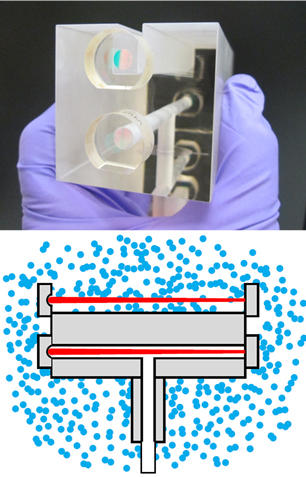Summary
This project is fundamentally changing the method for realizing and disseminating the SI unit of pressure, the pascale (Pa). The underlying principal behind this advance is the ultra-accurate determination of the refractive index of gases by picometer accuracy optical interferometry.
Description

Fixed Length Optical Cavity (FLOC) interferometer shown in a photo (top) and in Cross section (blue dots represent gas molecules and red lines represent laser path), reference here.
This project enables a quantum-based, SI-traceable method for realizing the pascal (Pa) while improving accuracy and allowing the replacement of existing mercury manometer pressure standards. The Fixed Length Optical Cavity (FLOC) pressure standard is a laser-based, SI-traceable primary pressure standard that precisely measures refractive index changes in a Fabry-Perot interferometer (proportional to gas pressure) and is traceable through the intrinsic properties of the gas being used (for example, helium or nitrogen)
The basic principle of operation behind the FLOC is that two laser cavities (consisting of a curved and a flat mirror) at a fixed distance apart will resonate when laser is tuned such that an integer number of ½ wavelengths fill the cavity (known as a Fabry Pérot resonance). When gas is added to one of the cavities, the light will transmit slower through the cavity with the gas and the laser frequency must then be adjusted the to maintain the cavity at resonance. The change in frequency is directly proportional to the change in index of refraction caused by the gas type and gas density (or pressure of the gas). For some gases, such as helium (He), the gas density-based relationship to refractive index is known from first principal quantum chemistry calculations, enabling the FLOC to operate as a quantum-based standard that is directly traceable to the International System of Units known as the SI.
The NIST FLOC, also known as the quantum pascal Optical Pressure Standard (OPS) and has an operational range of 1 Pa to 300 kPa with an uncertainty as low as 0.0009 % when using nitrogen gas. NIST is currently building the infrastructure and quality control documentation for implementing the FLOC for customer calibrations. Once implemented, the NIST mercury standards will be decommissioned. Active FLOC research projects at NIST include: Measurement of pressures below 1 Pa, Measuring pressures up to 400 kPa, Techniques for measuring differential pressure, Improving FLOC distortion measurements, Improving refractive index measurements for non-primary gases, and working with industry to help produce a portable FLOC for commercial applications under Collaborative Research and Development Agreements (CRADAs).
For more information:
https://www.nist.gov/noac/technology/thermodynamics/pressure

